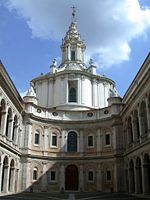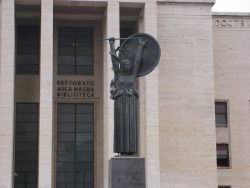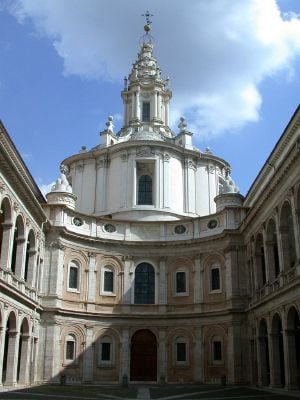University of Rome La Sapienza
 Latin: Studium Urbis | |
| Established | 1303 |
|---|---|
| Type | State-supported |
| Location | Rome, Italy |
| Website | www.uniroma1.it/ |
University of Rome La Sapienza (Italian Università degli Studi di Roma "La Sapienza") is the largest European university and the most ancient of Rome's three public universities. [1] In Italian, Sapienza means "wisdom" or "knowledge."
History

La Sapienza was founded in 1303 by Pope Boniface VIII, as a Studium for ecclesiastical studies more under his control than the universities of Bologna and Padua.
In 1431, Pope Eugene IV introduced a new tax on wine, in order to raise funds for the university; the money was used to buy a palace that later hosted the Sant'Ivo church, "La Sapienza."
According to the Catholic Encyclopaedia, the university "remained closed during the entire pontificate of Clement VII".[2] In 1870, La Sapienza stopped being the papal university and became the university of the capital of Italy. In 1935, the new university campus, planned by Marcello Piacentini, was completed.
In the academic year 2006-2007, La Sapienza had 21 faculties to its 138,000 students and was the largest university in Western Europe. It has many locations in Rome, but is mainly situated in the Città Universitaria, near Termini Station.
Organization
Faculties
The university is divided into 21 faculties:
- 1st Faculty of Architecture Ludovico Quaroni
- 2nd Faculty of Architecture Valle Giulia
- Faculty of Communication Sciences
- Faculty of Economics
- Faculty of Engineering
- Faculty of Humanities
- Faculty of Law
- Faculty of Literature and Philosophy
- Faculty of Mathematical, Physical and Natural Studies
- 1st Faculty of Medicine and Surgery
- 2nd Faculty of Medicine and Surgery
- Faculty of Oriental Studies
- Faculty of Pharmacy
- Faculty of Philosophy
- Faculty of Political Sciences
- 1st Faculty of Psychology
- 2nd Faculty of Psychology
- Faculty of Sociology
- Faculty of Statistics
- School for Aerospace Engineering
- School for Library and Archive Studies
Research centers & major research groups
- Centro Ricerche Aerospaziali, responsible for the Italian rocket program, based on San Marco platform
- [SPES - Development Studies]], research centre on Development studies at La Sapienza [3]
Famous scholars from La Sapienza
Sciences
- Lucio Bini and Ugo Cerletti, psychiatrists
- Corrado Böhm, computer scientist
- Daniel Bovet, pharmacologist, Nobel prize winner
- Benedetto Castelli, mathematician
- Andrea Cesalpino, physician and botanist
- Federigo Enriques, mathematician
- Maria Montessori, physician and paedagogist
- Vito Volterra, mathematician
Physicists
- Via Panisperna boys:
- Enrico Fermi, Nobel Prize winner;
- Edoardo Amaldi
- Oscar D'Agostino
- Ettore Majorana
- Bruno Pontecorvo
- Franco Rasetti
- Emilio G. Segrè, Nobel prize winner
- Giovanni Battista Beccaria
- Marcello Conversi
- Giovanni Ciccotti
- Giovanni Jona-Lasinio
- Francesco Guerra
- Luciano Maiani
- Giorgio Parisi
- Nicola Cabibbo, President of the Pontifical Academy Of Sciences
Humanities
- Luigi Ferri, philosopher
- Giovanni Vincenzo Gravina, jurisconsult;
- Umberto Cassuto, Hebrew language and Bible scholar
- Carlo Innocenzio Maria Frugoni, poet
- Count Angelo de Gubernatis, orientalist
- Santo Mazzarino, leading historian of ancient Rome and ancient Greece
- Giuseppe Tucci, orientalist
- Mario Liverani, orientalist
- Paolo Matthiae, director of the archeological expedition of Ebla
- Marcel Danesi, language scientist
- Giuliano Amato, law professor and twice Prime Minister of Italy
- Diego Laynez, second general of the Society of Jesus;
- Giulio Mazzarino, politician and cardinal
La Sapienza Alumni
- Severino Antinori, embryologist
- Sergio Balanzino, ambassador
- Bernardo Bertolucci, director
- Maurizio Cheli, astronaut
- Domenico Comparetti, classic literature scholar
- Gabriele D'Annunzio, poet
- Carlo Fea,
- Massimiliano Fuksas, architect
- Romaldo Giurgola, architect
- Umberto Guidoni, astronaut
- Antonio Monda, film director
- Luca di Montezemolo, CEO
- Scott O'Dell, novelist
- Crescenzio Cardinal Sepe, cardinal
- Abdirashid Ali Shermarke, president of Somalia
- Leopold Saverio Vaccaro, (honorary degree recipient), noted surgeon
Notes
- ↑ Istituto di Storia del Diritto Italiano Retrieved September 11, 2007.
- ↑ University of Rome Retrieved September 11, 2007.
- ↑ [http://w3.uniroma1.it/spes SPES Development Studies Research Centre at the University of Rome La Sapienza] Retrieved September 11, 2007.
ReferencesISBN links support NWE through referral fees
External links
- (Italian) University of Rome La Sapienza Website
Credits
New World Encyclopedia writers and editors rewrote and completed the Wikipedia article in accordance with New World Encyclopedia standards. This article abides by terms of the Creative Commons CC-by-sa 3.0 License (CC-by-sa), which may be used and disseminated with proper attribution. Credit is due under the terms of this license that can reference both the New World Encyclopedia contributors and the selfless volunteer contributors of the Wikimedia Foundation. To cite this article click here for a list of acceptable citing formats.The history of earlier contributions by wikipedians is accessible to researchers here:
The history of this article since it was imported to New World Encyclopedia:
Note: Some restrictions may apply to use of individual images which are separately licensed.
